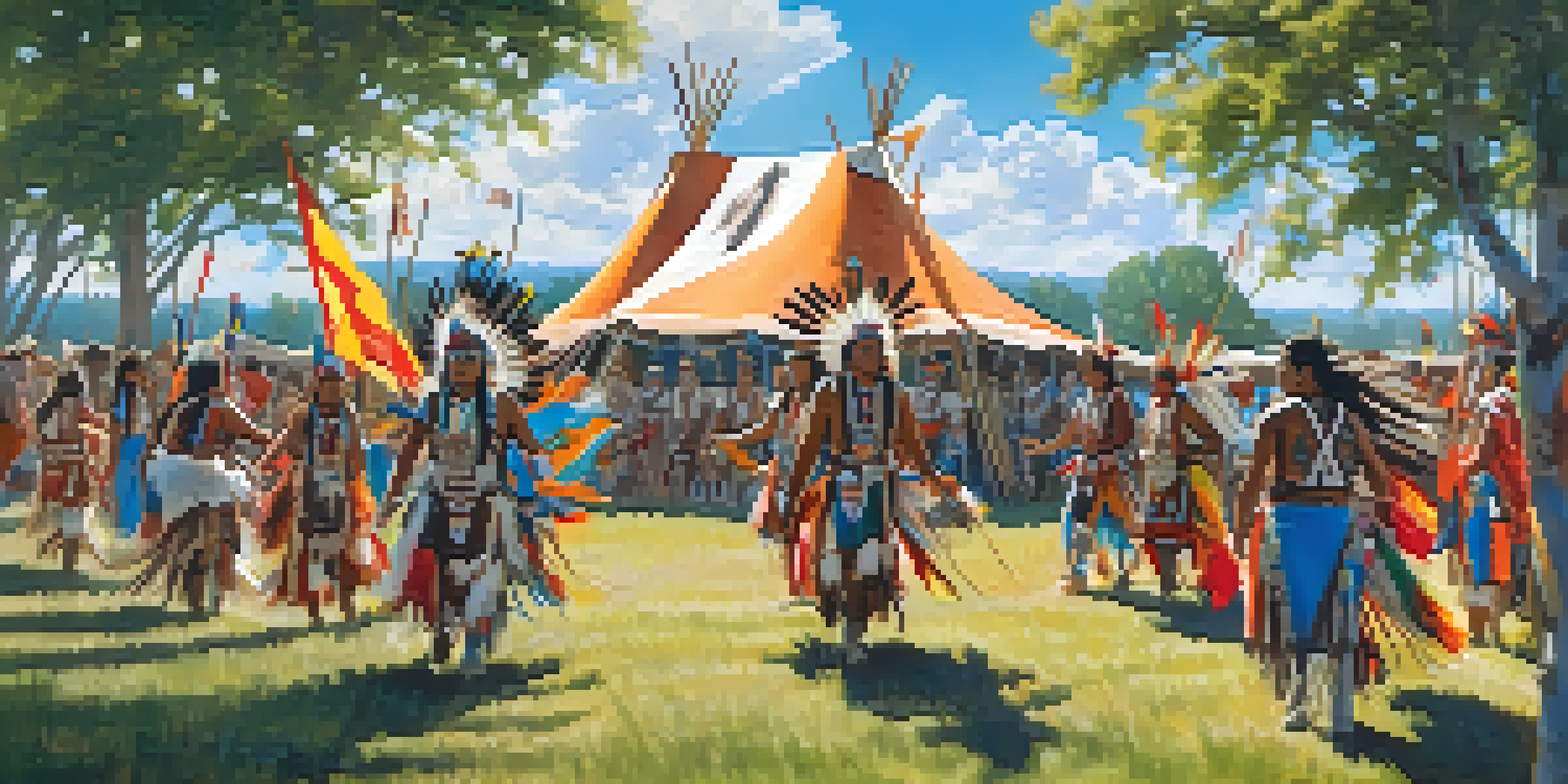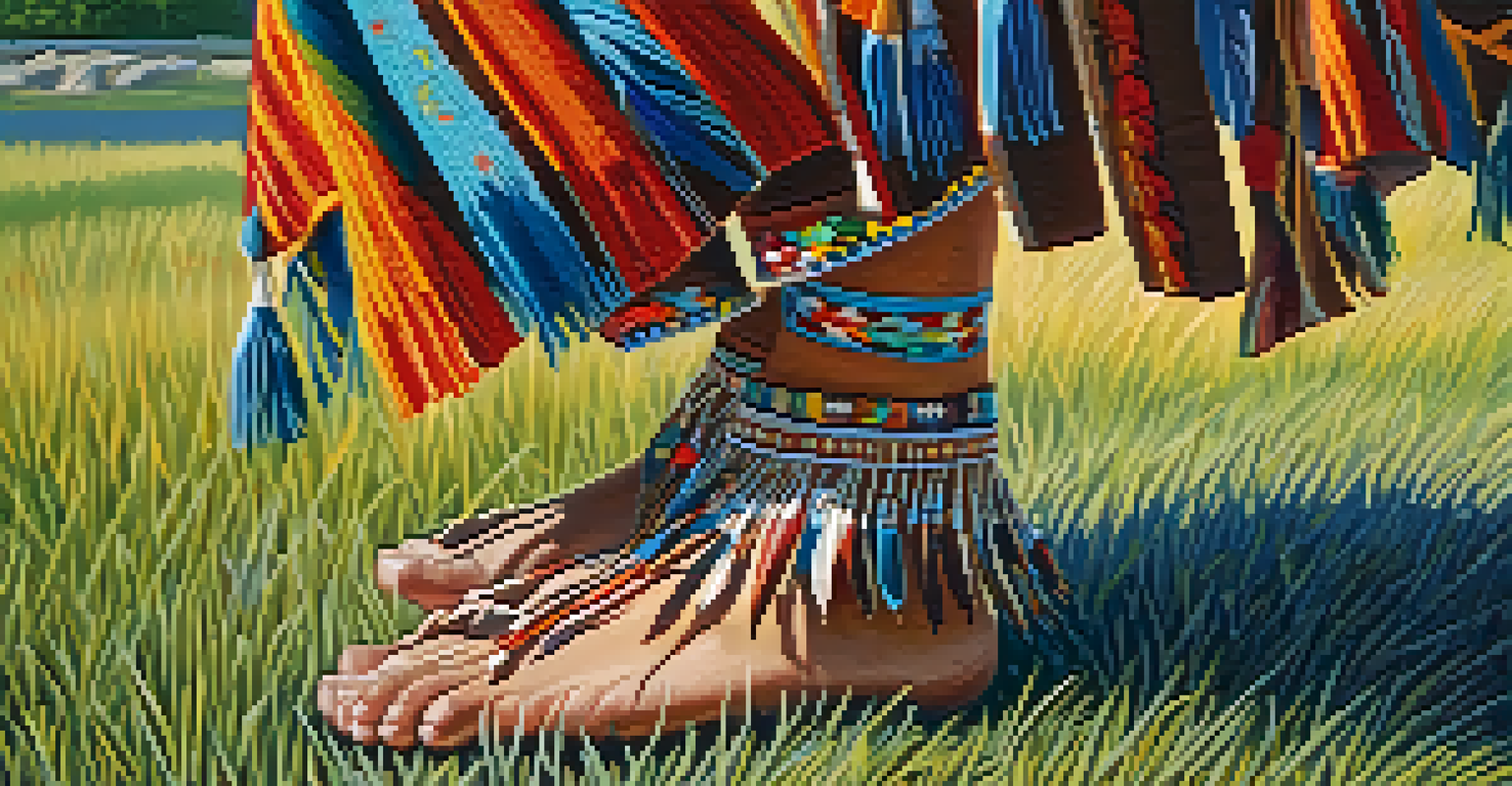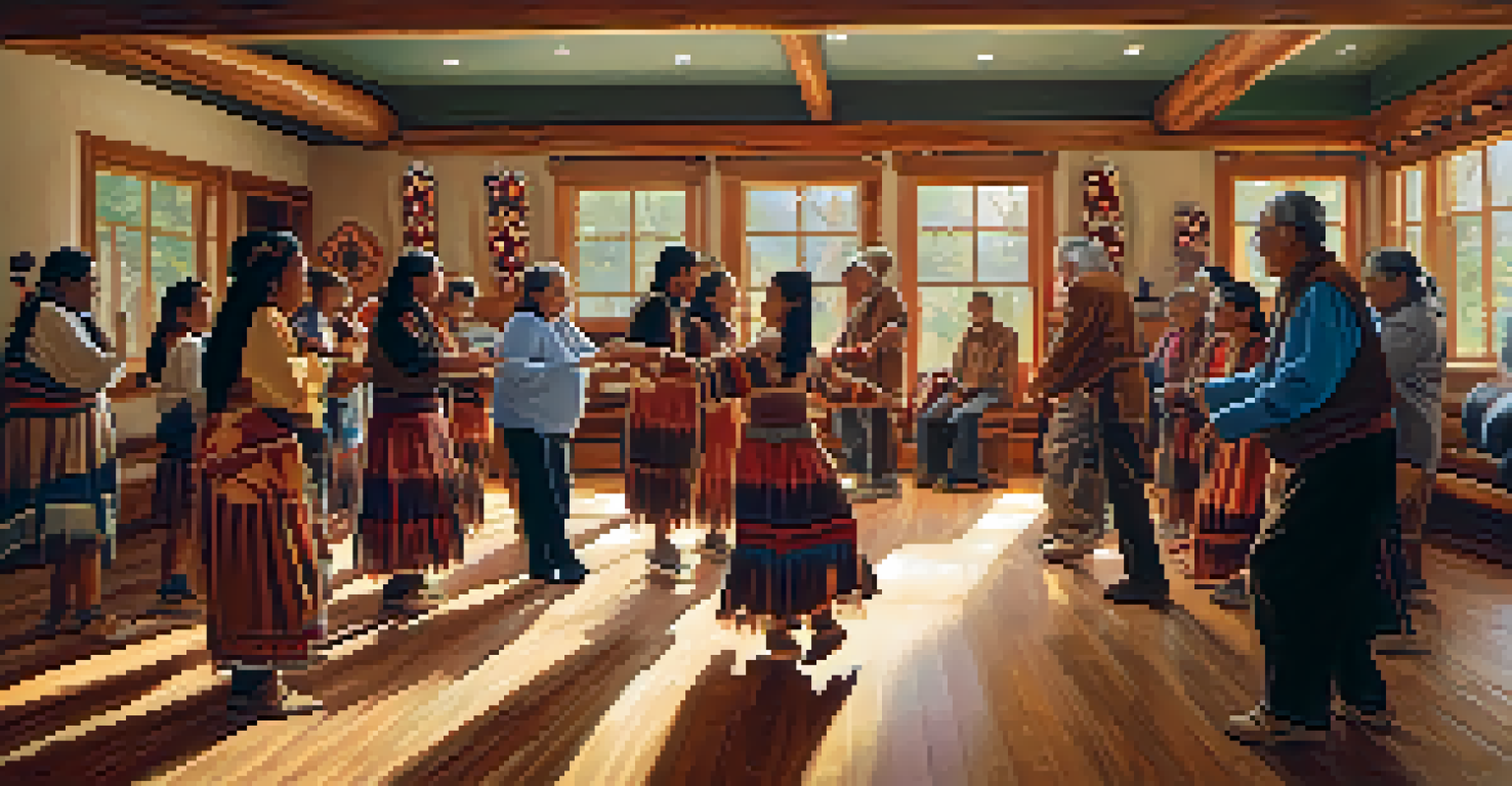The Significance of Folk Dance in Native American Cultures

Understanding the Role of Folk Dance in Native American Life
Folk dance in Native American cultures serves as a vibrant expression of identity and community. It's not just about movement; it's a way to tell stories, preserve history, and celebrate traditions. Each dance is imbued with meaning, often reflecting the beliefs and values of the tribe, making it an essential aspect of their cultural heritage.
Dance is the hidden language of the soul.
Traditionally, these dances would occur during significant events, such as harvests, ceremonies, and festivals, creating a sense of unity among participants. As community members come together to dance, they reinforce social ties and create lasting memories. This collective experience fosters a strong sense of belonging and identity, which is vital for the survival of their cultural narratives.
Moreover, folk dance also serves as a bridge between generations. Elders pass down not just the steps but the stories and teachings associated with each dance. This intergenerational transfer of knowledge ensures that the rich tapestry of traditions continues to thrive, connecting the past with the present.
Cultural Significance of Specific Folk Dances
Each Native American tribe has its own unique folk dances, each with specific cultural significance. For instance, the Powwow is a gathering that features various dances that celebrate Native American culture, showcasing the diversity and richness of different tribes. Participants often wear traditional regalia, which adds to the visual splendor and significance of the event.

Another example is the Grass Dance, which is traditionally performed to honor the earth and its bounty. The dance mimics the movement of grass swaying in the wind, symbolizing harmony with nature. Such dances not only serve a ceremonial purpose but also reinforce the connection between the people and their environment, highlighting respect for the land.
Folk Dance as Cultural Identity
Folk dance serves as a vital expression of identity and community among Native Americans, preserving their history and traditions.
These dances often incorporate elements such as drumming and singing, adding layers of meaning and emotion. The rhythms and melodies are integral to the experience, enhancing the spiritual connection felt by participants and observers alike. In this way, folk dance becomes a powerful medium for expressing the values and beliefs of Native American cultures.
Folk Dance as a Means of Cultural Preservation
In a world where globalization threatens many indigenous cultures, folk dance plays a crucial role in cultural preservation. By actively participating in traditional dances, Native Americans can keep their heritage alive and share it with younger generations. This practice not only sustains cultural identity but also instills pride in their roots.
The dance is a poem of which each movement is a word.
Moreover, many tribes are now using folk dance as a way to educate others about their culture. Dance performances at schools and community events help dispel stereotypes and foster understanding among diverse audiences. This outreach is vital in creating a dialogue between cultures, promoting respect and appreciation for Native American traditions.
In addition, festivals and gatherings dedicated to folk dance encourage community engagement and participation, reinforcing the importance of these traditions. Through such initiatives, Native Americans can reclaim their narratives and ensure that future generations continue to honor and celebrate their rich cultural heritage.
The Role of Spirit and Meaning in Folk Dance
Folk dance in Native American cultures is deeply spiritual, often involving rituals and prayers. Each movement is intentional, designed to convey respect for ancestors, nature, and the spirit world. Dancers often enter a trance-like state, connecting their physical movements with deeper spiritual meanings.
This spiritual connection is further emphasized by the use of songs and chants that accompany the dances. These elements are not merely entertainment; they are integral to the experience, serving to invoke the presence of spirits and honor the divine. Thus, folk dance transcends mere performance, becoming a sacred act that fosters a deeper connection to the cosmos.
Spiritual Connection in Dance
Each movement in folk dance is intentional, conveying respect for ancestors and nature while fostering a deeper spiritual bond.
Through these spiritual practices, dancers reinforce their cultural identity and community bonds. The act of dancing becomes a form of prayer, a way to express gratitude and seek guidance. In this way, folk dance is not just a cultural artifact; it is a living expression of the spiritual beliefs that underpin Native American life.
The Evolution of Folk Dance in Modern Times
As society evolves, so too does the expression of folk dance in Native American cultures. While traditional dances are still performed, many tribes are also innovating and incorporating contemporary elements into their performances. This evolution helps to keep the dances relevant and appealing to younger generations, ensuring their survival.
Modern folk dance may blend traditional movements with influences from other dance styles, reflecting the dynamic nature of cultural expression. Such adaptations can help attract diverse audiences, making it easier to share the rich narratives and histories of Native American tribes. This fusion of old and new creates a vibrant tapestry that honors the past while embracing the future.
Despite these changes, the core values and meanings of folk dance remain intact. The emphasis on community, spirituality, and storytelling continues to resonate, reminding everyone of the importance of preserving cultural heritage. As tribes navigate the complexities of modern life, folk dance remains a vital thread connecting them to their ancestors and their identity.
Folk Dance as a Tool for Advocacy and Awareness
Folk dance has emerged as a powerful tool for advocacy within Native American communities. By showcasing their rich traditions through dance, tribes can raise awareness about various social issues affecting their people, such as land rights, environmental concerns, and cultural preservation. This visibility is crucial in advocating for their rights and interests.
Events like powwows and cultural festivals not only celebrate heritage but also provide a platform for educating the public about the challenges faced by Native Americans today. Through vibrant performances, they can share their stories and highlight the ongoing struggles for recognition and respect. This advocacy through dance fosters solidarity and support within and outside the community.
Advocacy Through Dance
Folk dance acts as a powerful tool for raising awareness about social issues, promoting solidarity and understanding within and outside Native communities.
Furthermore, the participation of non-Native audiences in these events can lead to greater empathy and understanding. As people witness the beauty and significance of these dances, they may become allies in the fight for justice and equity. In this way, folk dance transcends entertainment, becoming a means of social change and awareness.
The Future of Folk Dance in Native American Communities
Looking ahead, the future of folk dance in Native American communities seems promising yet challenging. As younger generations embrace their heritage, there is hope that they will continue to practice and pass down traditional dances. This commitment is essential for keeping their cultural identity alive in an ever-changing world.
However, these communities also face challenges, including the risk of cultural appropriation and misrepresentation. It's crucial for Native Americans to assert their narratives and ensure that their traditions are respected and understood. Engaging in dialogues with non-Native people can help foster mutual respect and appreciation for their cultural practices.

Ultimately, the resilience of folk dance reflects the strength of Native American cultures. As these communities continue to navigate modernity while honoring their past, folk dance will undoubtedly remain a vital expression of their identity, spirituality, and unity. The commitment to preserving these traditions will ensure that future generations can dance, celebrate, and share their stories with pride.